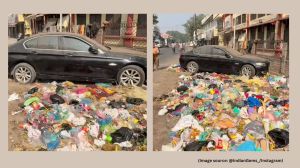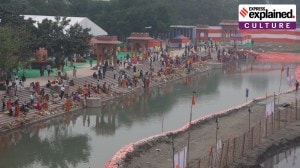Draconian assault on citizens’ rights
POTA is finally on its way out. But even before its demise, the groundwork is being done for the enactment of an equally draconian legislati...

POTA is finally on its way out. But even before its demise, the groundwork is being done for the enactment of an equally draconian legislation. The reaction in certain quarters to the decision to repeal POTA is akin to the ideological offensive mounted by the police in the interregnum after the repeal of TADA and the enactment of POTA. At that time, senior police officers appeared on television denouncing the ‘‘slack’’ approach of the judiciary in combating terrorism.
Referring to the low rate of conviction in TADA cases—1 per cent—we were told that while the police were alert in nabbing terrorists, the judiciary with its archaic laws and hyper-technical approach was letting them go scotfree. Some policemen were so bold as to hint that fake encounters were a necessary evil given the abysmal record of the judiciary.
Judges cannot come on prime time television. But if they could, they would tell us how the police mishandle serious cases resulting in acquittals. They would give the reasons for acquittals ranging from the roping in of innocent people, to corruption and political vendettas. And as for the charge of delay in trials, that was answered by Chief Justice Patnaik himself when he said that government was asleep for a long time and it was the Supreme Court that woke them up to the urgent need to appoint additional judges. India has one-fifth the required number of judges.
To understand why TADA and POTA had to go, one must know their two core provisions. The first is the section that makes admissible in evidence confessions of the accused before a police officer, and the second is the harsh provision regarding bail.
Confessions recorded by a police officer have, even under the British, been barred as inadmissible on the ground that torture by the police is routine. TADA and POTA changed that on the facile assumption that since the confessions would be made only to a senior police officer, that was a sufficient safeguard to ensure a fair trial.
Once such confessions were made admissible, it was easy to torture an accused, take his signature on a ‘confession’ and prosecute the accused solely on the basis of that piece of paper. An enlightened estimate would put the extent of confessions extracted by force at 90 per cent.
After the ‘confession’ is taken, the bail provision comes into play. Under normal criminal law, bail is granted on a consideration as to whether the accused is likely to turn up for his trial. Under TADA and POTA, however, the judge is required to come to the conclusion that the accused has not committed the offence. This is nigh impossible at the stage of the chargesheet because the ‘confession’ is put on record. The accused may vehemently protest his innocence and say that his confession was taken by force, but the truth of that protest can only be decided at his trial, when evidence is led and cross-examination done, perhaps six years later!
Those who therefore cite the 1 per cent conviction rate as an indicator of the ineffectiveness of the judiciary miss the point of the remaining 99 per cent wasting valuable years of their lives in jail. Moreover this was not an aberration in the system. Delay and the use of security legislation as a sort of preventive detention was the core of the strategy. Conviction on the basis of forensic evidence was never a critical concern. In fact, in many cases, evidence did not exist at all, the police knowing right from the beginning that a conviction would be impossible.
Reviewing TADA, the Constitutional Bench in Kartar Singh’s case held: ‘‘It is heartrending to note that day in and day out, we come across news of blood-curdling incidents of police atrocities.’’ Yet it accepted as valid the provisions because only senior officers were permitted to record such confessions and the Court presumed that such officers would be less inclined to use force.
Justice Ramaswamy delivered a prophetic dissent, saying, ‘‘Such a provision shocked the conscience and smelt of unfairness. Conferment of judicial power on the police will erode public confidence in the administration of justice.’’ Dealing specifically with the defence that senior officers should be trusted to record confessions fairly, he retorted: ‘‘It is not the hierarchy of officers but the source. It is obnoxious to confer power on police officers. A sub-inspector of police may be uncouth as compared to a superintendent of police but the basic philosophy of the two remain the same. Procedural fairness does not have much meaning for them.’’ Even after Independence, a force that was created to implement the draconian laws of an imperial regime ruthlessly has not changed much even in the peoples’ regime.
Finally, dealing with the threat of terrorism, he warned: ‘‘Killing of democracy by gun and bomb should not be permitted. But in doing so, the State has to be vigilant not to use methods which may be counter-productive. Care must be taken to distinguish between terrorists and the innocent.’’
A single thread runs through the decisions of the Constitutional Bench upholding the provisions of the Armed Forces (Special Powers) Act, TADA and POTA. This is the presumption that since these laws are exceptionally harsh and give unprecedented powers to the State, they would be used prudently. In the PUCL case, where the constitutionality of POTA was challenged, the Supreme Court held: ‘‘The mere possibility of abuse cannot be a ground for declaring a statute unconstitutional.’’ But was it only a mere possibility or widespread actual abuse?
A fact-finding report prepared by Justice Hosbet Suresh into the use of the Armed Forces Act in Manipur documented numerous cases of senseless revenge killings of innocent people by the Assam Rifles and CRPF after the latter were attacked by militants in hit-and-run operations. Similarly, during the proceedings of the ‘People’s Tribunal on POTA’ held at Delhi, victims spoke of how minorities, Dalits, adivasis, industrial workers and juveniles had been tortured and jailed.
Listening to the ‘‘ragged and wretched’’ who deposed, from the minorities of Gujarat to the children of Jharkhand, Syeda Hameed, a Tribunal member, was moved by ‘‘the grim faces etched with stories of human despair’’. Horrific cases of custodial torture came before the Tribunal. The hypothesis of the State, she concluded, was that ‘‘terror is spread only by the poor’’. In effect this legislation ‘‘creates terrorists in every state’’. The State must fight terrorism with all its might. But is this the way to do it?
It is said that we needed POTA to nab terrorists. All harsh provisions that curtail human rights do have a by-product—of incrementally increasing the number of terrorists caught. But in the process the police—already a substantially criminalised force—increase their power to dominate civil society and undermine democratic institutions and processes. That is too great a price for society to pay!
POTA has gone. But lurking ominously in the background is the ‘Malinath Report’ with its infamous recommendations that POTA-like provisions be inserted in normal criminal law. When will we ever learn?
The writer is a Supreme Court lawyer and human rights activist



- 01
- 02
- 03
- 04
- 05




























